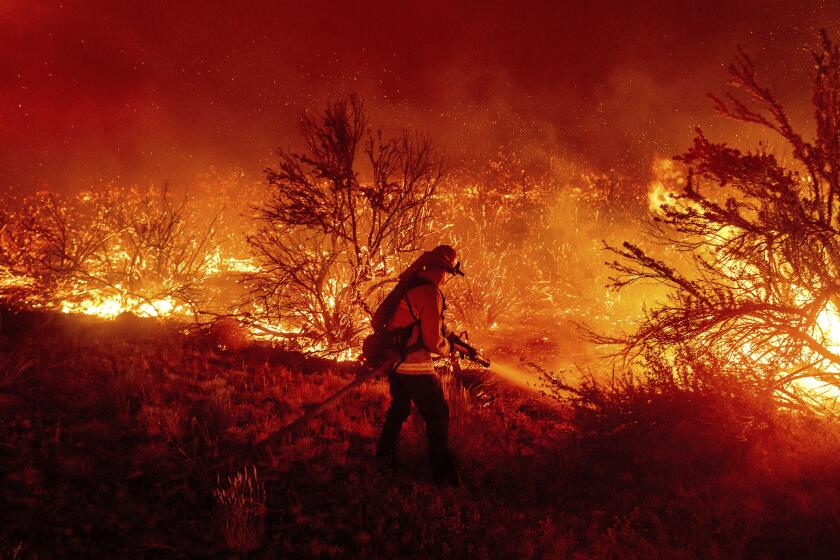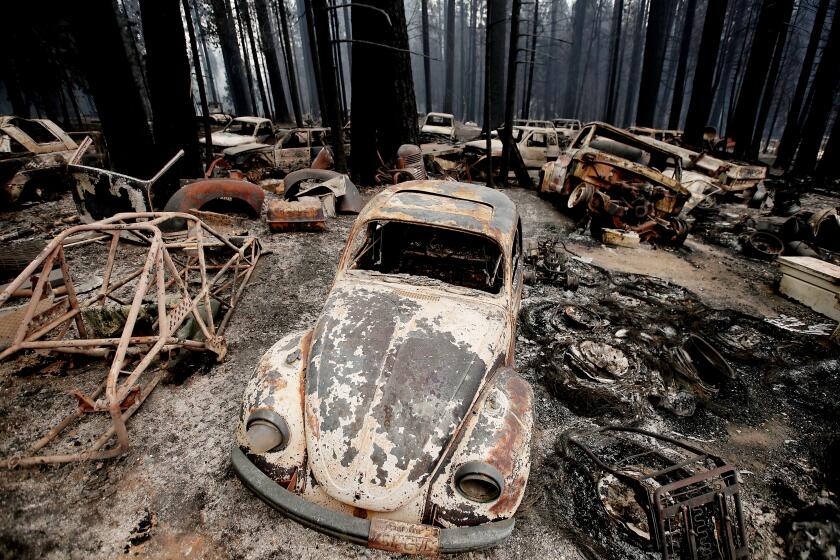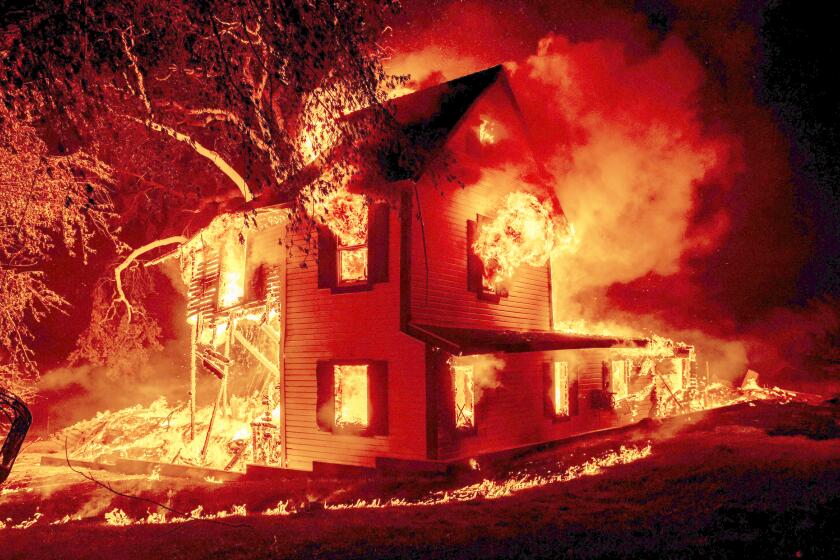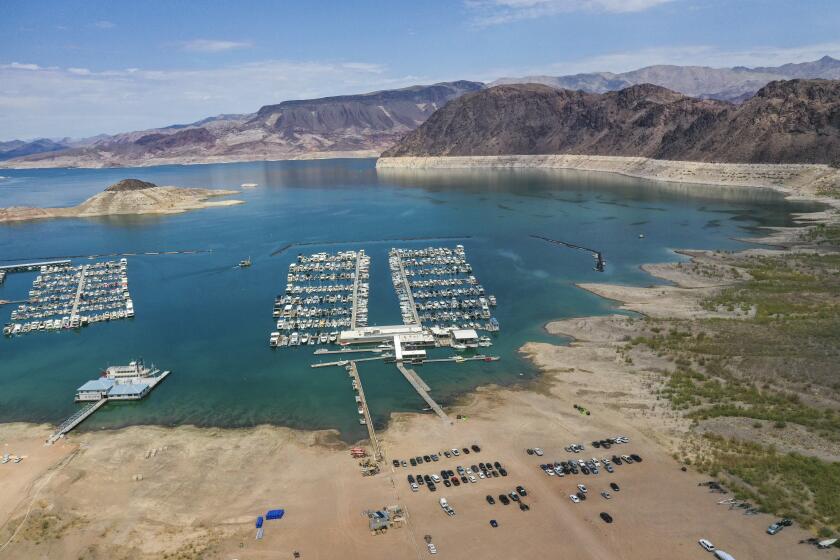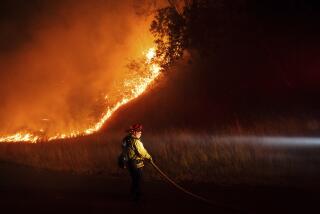California faces unprecedented dangers as record heat, dryness combine with fierce winds
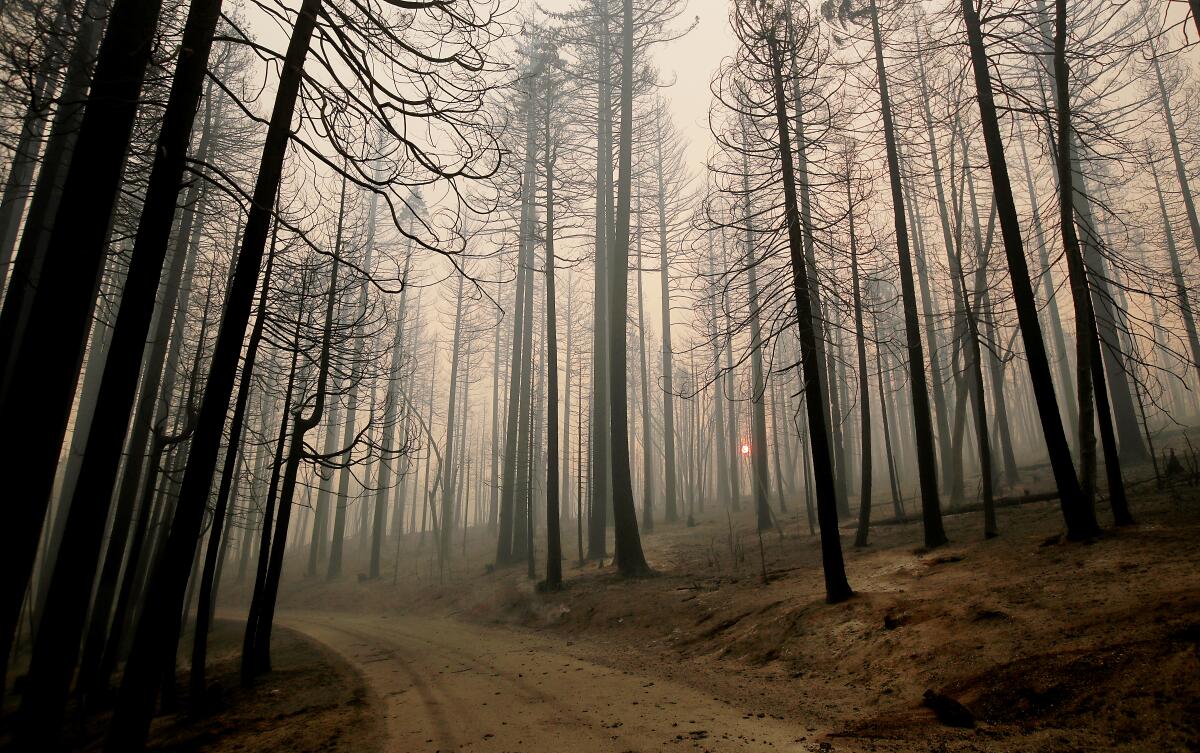
- Share via
With more than a million acres burned fairly early in the fire season, California is entering uncharted territory as the record dry conditions that have fueled so much destruction will soon combine with seasonal winds that fire officials fear will bring unprecedented dangers.
Officials have attributed warming temperatures and worsening drought to the explosive growth of fires, mostly in the mountains of Northern California, this summer.
And while the fire-prone state has seen gusty winds this season, many experts fear that the impending arrival of strong Santa Anas and Diablos — which typically move in around mid-September — could mark even more misery for weary residents and beleaguered fire crews.
“We’re coming into the high fire season, and right now we’re on our knees,” said climatologist Bill Patzert. “The weather is the wildcard, and the weather patterns have shifted. Looking ahead here, it’s hard to be optimistic.”
The Dixie fire, the largest wildfire in California history, grows to 635,728 acres and now threatens Susanville. It has burned for more than a month.
Already, strong winds caused a fire north of Sacramento to explode, burning through one town and spurring evacuations. A second fire raged in Lake County, destroying homes.
Then there is the monstrous Dixie fire — the second-largest in the state’s recorded history — now making a run toward Susanville. Dixie has been burning for more than a month, and the danger zone now stretches across a wide swath of the region from Lassen to Butte.
Firefighters and climate experts are bracing for a challenging few months, with strong winds expected to move in soon. Winds have always fanned devastating fires, but it remains to be seen how they will combine with the dry terrain that has already created so much unpredictable fire behavior this year.
“To have fires of this magnitude so early is very unusual,” said Alex Hall, director of the UCLA Center for Climate Science. “And in much of California, historically, the heart of the fire season — especially for big fires — is the time of year when the Santa Ana and Diablo winds kick in.”
To Hall and others, the conditions this year underscore how the changing climate is fundamentally altering the dynamics of fighting and surviving fires in California. Many of the ingredients are in place for another flame-filled fall.
“The dice are loaded,” he said. “It’s very likely that we have much more of the fire season to come.”
The Caldor fire surges to nearly 63,000 acres with 0% containment Wednesday evening, and officials describe its behavior as ‘unprecedented.’
The state passed the 1 million-acre mark Saturday, according to the California Department of Forestry and Fire Protection — the same day the Caldor fire ignited south of Grizzly Flats.
By Wednesday, the number had already grown to more than 1.3 million acres.
Cal Fire Assistant Deputy Director Daniel Berlant said hitting the milestone in California is a rarity in any year, and even more so when it happens this early.
“It’s very concerning that we’ve already had over a million acres by August,” he said. “We are well ahead of the acreage in the same time period last year — and last year was a record-setting year.”
Not only have wildfires arrived earlier this year, but they have also been destructive. The multicounty, 635,000-acre Dixie fire already reduced the town of Greenville to ashes.
Strong winds also helped spur significant growth of the Caldor fire in El Dorado County, which exploded from 6,500 acres Tuesday to more than 50,000 acres by Wednesday. Red flag warnings have been issued across much of Central and Northern California.
Officials said it grew so rapidly at one point that they had trouble keeping an accurate perimeter on the map.
“This fire has done things that nobody could have predicted,” Eldorado National Forest supervisor Jeff Marsolais said during a community meeting Tuesday, “but that’s how firefighting has been in the state this year.”
Both of the fires have been driven by the heat and drought, which together have dried the state’s landscape to the point of extreme combustibility. Strong winds have fanned their flames and sent their embers aloft, and the seasonal Santa Anas and Diablos haven’t even arrived in full force.
“September and October is traditionally when the largest and the most destructive fires have occurred, and primarily that’s due to the fact that that’s the time period when, traditionally, we would see wind events like Santa Anas,” Berlant said.
“Plus it’s the point of the season when conditions have been dried out all summer long, and it’s the longest point we’ve gone without rainfall.”
In Susanville on Wednesday, interim City Administrator Dan Newton — who was evacuated from his home this week — worried that dwindling winds in the area might mean the fire is headed for another community.
“We are all kind of taking turns with the imminent danger,” he said. “It’s hit, obviously, a lot of communities already.”
Roughly 51,000 customers in Northern California may lose power Tuesday, the utility said.
The Santa Anas — and their Northern California counterpart, Diablos — are a recurrent weather phenomena in the state, explained Park Williams, a bioclimatologist and associate professor at UCLA.
Most years starting around September or October, the winds move in from the high deserts toward the oceans. They get pressurized and hotter as they travel, and when they hit the state’s mountain passes and canyons, they get faster.
“It’s the perfect recipe for fire as long as all the vegetation on the landscape is dry,” Williams said.
The landscape is undoubtedly dry this year. Rainfall and snowmelt have been scant, and the ongoing drought is shriveling the region’s lakes, reservoirs and vital water sources.
Like monsoons and other weather patterns, Santa Anas and Diablos are hard to predict more than a few days out, Williams said, so climate experts can’t say for sure whether or when they will happen in a given year.
If they don’t arrive, there is a chance that California could see some reprieve from fire. But there is a strong probability that they will show up.
“To have big fires in the fall really takes a convergence of a few pieces of bad luck,” Williams said. “Those pieces of bad luck are: You need a really big Santa Ana wind event ... and you need that to occur before the winter rainy season has really started up.”
Like the wind, rains are hard to predict too far in advance, but most experts said moisture probably isn’t in the forecast anytime soon.
“For years I talked about the race between the Santa Anas and the rains, which really determined the fire season,” Patzert said. “But the rainy season is coming later and it’s leaving earlier. It’s compressed.”
Southern California water district calls for local agencies and consumers to voluntarily reduce water consumption to avoid more severe restrictions.
Patzert said there are other factors that could contribute to a bad fire season this fall, including dry lightning events like the ones that ignited so many terrible fires last year.
The August Complex — the state’s first million-acre fire — was composed of dozens of smaller fires sparked by an unusually fierce lightning storm that saw more than 12,000 strikes over 96 hours.
That record-breaking fire began this same week — mid-August — last year.
And although climate change is creating drier conditions on the ground, some scientists say it is also creating humidity higher in the atmosphere, Patzert said. That kind of instability could increase the likelihood of more lighting strike clusters moving forward.
What’s more, the National Oceanic and Atmosphere Administration is warning of a possible La Niña emergence, which usually means below normal rainfall for the region, Patzert said.
Also of concern is continued exposure to wildfire smoke, which is blanketing not only California but much of the continent.
Smoke from the Caldor and other fires on Wednesday prompted an air quality advisory in the Bay Area, while wildfire cameras captured fiery columns, billowing flames and eerie orange skies. Studies have found that wildfire smoke can contain bacteria, heavy metals and other dangerous substances.
The conditions are difficult for both residents and firefighters working to extinguish the flames. Cal Fire said more than 10,000 personnel are now battling 12 active large fires across the state.
Berlant said the agency is doing its best to keep crews motivated and healthy, but weeks of fighting fire — with no finish line in sight — is taking its toll.
“We really have to pace [crews], and ourselves, because we have many more months before the winter season approaches,” he said. “We have to constantly prioritize our resources.”
So far, drought-related water restrictions across the state haven’t affected firefighters’ ability to fight flames, Berlant said, although he could envision a scenario in which aerial crews might have to fly a little farther to replenish supplies for water drops.
More to Read
Sign up for Essential California
The most important California stories and recommendations in your inbox every morning.
You may occasionally receive promotional content from the Los Angeles Times.
